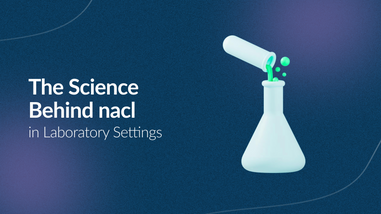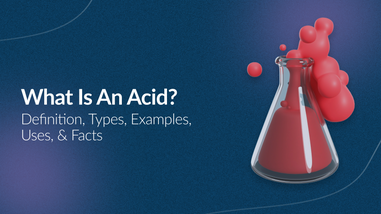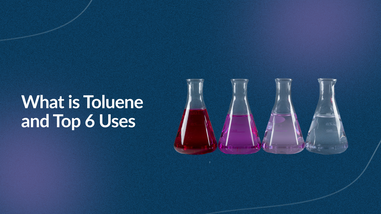- No products in the cart.
Nitric acid (HNO3) is a highly corrosive mineral acid. It's also known as aqua fortis, which in Latin means "strong water." Nitric acid in its pure state is colorless, but you may see that older samples have more of a yellowish color due to decomposition into oxides of nitrogen and water.
Most commercially available nitric acid has a concentration of 68% - 70% in water. When the solution contains more than 86% of nitric acid, it's referred to as fuming nitric acid; a commercial grade of fuming nitric acid contains 98% of Nitric Acid and has a density of 1.50 g/cm3. This grade is often used in the explosives industry, as it's not as volatile nor as corrosive as the anhydrous acid.
Depending on the amount of nitrogen dioxide present, fuming nitric acid is further characterized as red fuming nitric acid at concentrations above 86% or white fuming nitric acid at concentrations above 95%.
Nitric acid is also used in the digestive process of turbid or sludge water samples. When mixed with hydrochloric acid, it produces aqua regia. Nitric acid is used either in combination with hydrochloric acid or alone to clean glass coverslips and glass slides for high-end microscopy applications.
 etching in printmaking, pickling stainless steel, or cleaning silicon wafers in electronics.
etching in printmaking, pickling stainless steel, or cleaning silicon wafers in electronics.
A solution of nitric acid, water, and alcohol, which is known as Nital, is used for etching metals. This unique technique carefully removes the top layers of metal to create a visible shape. It also reveals the microstructure of the metal, usually copper, steel or zinc. Nitric acid is used in the fertilizing industry in the production of ammonium nitrate as well.
Nitric Acid is also used to clean glass before silvering during the process of making silver mirrors. At around 10% in an aqueous solution, nitric acid is used in woodworking for aging Maple or Pine. This lower concentration of acid produces a gray–gold during the aging process of both kinds of wood, very much like an old wax or oil-finished wood.
Other uses include the jewelry industry to dissolve gold and platinum. Nitric acid is used in the printing industry producing dyes. Nitric acid has been used in various forms as the oxidizer in liquid-fueled rockets. In organic synthesis, nitric acid may be used to introduce the nitro group. When used with sulfuric acid, it generates the nitronium ion, which electrophilically reacts with aromatic compounds such as benzene.
In electrochemistry, nitric acid is used as a chemical doping agent for organic semiconductors and purification processes for raw carbon nanotubes.
Workers may be harmed from exposure to nitric acid. The level of exposure depends upon the dose, duration, and work being done. Nitric acid is incompatible and can react violently with many substances. Examples include but are not limited to: Acetic anhydride; Acetone; Acetonitrile; Alcohols; Alkali metals; Amines; Ammonia; Benzene; Bases; Carbides; Copper; Dichloromethane; Dimethyl sulfoxide; Flammable liquids and gases; Formic acid; Heavy metals; Hydrogen sulfide; Ketones; Metallic powders; Phosphorus; Reducing agents; Thiols; Toluene; Turpentine.
Nitric acid shall not be disposed to the sewers because its pH can damage aquatic organisms. If need to dispose of nitric acid, chemical waste generators must determine whether a discarded chemical is classified as a hazardous waste. Chemical waste generators must also consult local, regional, and national hazardous waste regulations to ensure complete and accurate classification.
For over 40 years, Lab Pro Inc. has been committed to providing a wide range of chemicals such as nitric acid in California. To learn more, visit the biggest Lab Supply showroom in California, or contact us online or at 888-452-2776.
Most commercially available nitric acid has a concentration of 68% - 70% in water. When the solution contains more than 86% of nitric acid, it's referred to as fuming nitric acid; a commercial grade of fuming nitric acid contains 98% of Nitric Acid and has a density of 1.50 g/cm3. This grade is often used in the explosives industry, as it's not as volatile nor as corrosive as the anhydrous acid.
Depending on the amount of nitrogen dioxide present, fuming nitric acid is further characterized as red fuming nitric acid at concentrations above 86% or white fuming nitric acid at concentrations above 95%.
Nitric Acid 70%
When at 70% concentration, nitric acid is used mainly in medical laboratories for standards that are purified and characterized for use in trace element analysis in the low parts-per-billion range. It's also popular in school laboratories.Nitric acid is also used in the digestive process of turbid or sludge water samples. When mixed with hydrochloric acid, it produces aqua regia. Nitric acid is used either in combination with hydrochloric acid or alone to clean glass coverslips and glass slides for high-end microscopy applications.
Nitric Acid 90%
Nitric Acid 90% is corrosive and is primarily used in specialty applications, such as
A solution of nitric acid, water, and alcohol, which is known as Nital, is used for etching metals. This unique technique carefully removes the top layers of metal to create a visible shape. It also reveals the microstructure of the metal, usually copper, steel or zinc. Nitric acid is used in the fertilizing industry in the production of ammonium nitrate as well.
Nitric Acid is also used to clean glass before silvering during the process of making silver mirrors. At around 10% in an aqueous solution, nitric acid is used in woodworking for aging Maple or Pine. This lower concentration of acid produces a gray–gold during the aging process of both kinds of wood, very much like an old wax or oil-finished wood.
Other Nitric Acid Uses
Nitric acid is used to make intermediates in the polymer industry: in the manufacture of hexanedioic acid (adipic acid) to make polyamides, TDI (toluene diisocyanate or methylbenzene diisocyanate), and dinitrobenzene two of a range of reagents used to make polyurethanes.Other uses include the jewelry industry to dissolve gold and platinum. Nitric acid is used in the printing industry producing dyes. Nitric acid has been used in various forms as the oxidizer in liquid-fueled rockets. In organic synthesis, nitric acid may be used to introduce the nitro group. When used with sulfuric acid, it generates the nitronium ion, which electrophilically reacts with aromatic compounds such as benzene.
In electrochemistry, nitric acid is used as a chemical doping agent for organic semiconductors and purification processes for raw carbon nanotubes.
Safety First
Nitric acid is an extremely corrosive acid capable of causing severe chemical burns very rapidly. If nitric acid mists are inhaled, health risks include corrosion of mucous membranes, delayed pulmonary edema pneumonitis, bronchitis, and dental erosion, and even death. Contact with eyes can cause permanent cornea damage.Workers may be harmed from exposure to nitric acid. The level of exposure depends upon the dose, duration, and work being done. Nitric acid is incompatible and can react violently with many substances. Examples include but are not limited to: Acetic anhydride; Acetone; Acetonitrile; Alcohols; Alkali metals; Amines; Ammonia; Benzene; Bases; Carbides; Copper; Dichloromethane; Dimethyl sulfoxide; Flammable liquids and gases; Formic acid; Heavy metals; Hydrogen sulfide; Ketones; Metallic powders; Phosphorus; Reducing agents; Thiols; Toluene; Turpentine.
Nitric acid shall not be disposed to the sewers because its pH can damage aquatic organisms. If need to dispose of nitric acid, chemical waste generators must determine whether a discarded chemical is classified as a hazardous waste. Chemical waste generators must also consult local, regional, and national hazardous waste regulations to ensure complete and accurate classification.
For over 40 years, Lab Pro Inc. has been committed to providing a wide range of chemicals such as nitric acid in California. To learn more, visit the biggest Lab Supply showroom in California, or contact us online or at 888-452-2776.












































